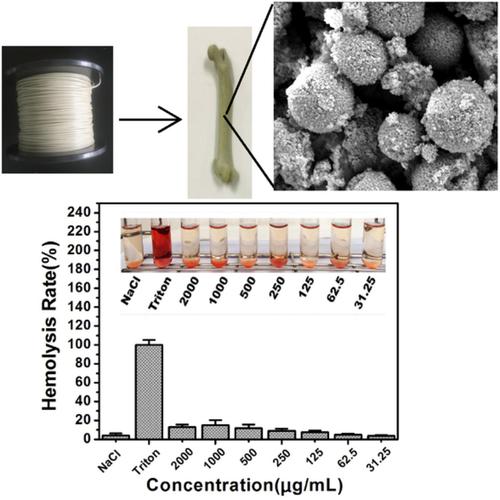当前位置:
X-MOL 学术
›
J. Appl. Polym. Sci.
›
论文详情
Our official English website, www.x-mol.net, welcomes your feedback! (Note: you will need to create a separate account there.)
Biocompatible heterogeneous bone incorporated with polymeric biocomposites for human bone repair by 3D printing technology
Journal of Applied Polymer Science ( IF 3 ) Pub Date : 2020-11-24 , DOI: 10.1002/app.50114 Meiling Wan 1 , Shuifeng Liu 1 , Da Huang 2 , Yang Qu 1 , Yang Hu 1 , Qisheng Su 1 , Wenxu Zheng 1 , Xianming Dong 1 , Hongwu Zhang 2 , Yen Wei 3 , Wuyi Zhou 1
Journal of Applied Polymer Science ( IF 3 ) Pub Date : 2020-11-24 , DOI: 10.1002/app.50114 Meiling Wan 1 , Shuifeng Liu 1 , Da Huang 2 , Yang Qu 1 , Yang Hu 1 , Qisheng Su 1 , Wenxu Zheng 1 , Xianming Dong 1 , Hongwu Zhang 2 , Yen Wei 3 , Wuyi Zhou 1
Affiliation

|
Polylactic acid (PLA) has become a popular polymer material due to its superior biocompatibility. At present, there are a few relevant research on heterogeneous bone powder. Besides, the poor dispersibility and adhesivity of inorganic particles in the organic phase remains a problem. In this study, the pork bone powders were modified with N‐butanol to improve its dispersibility and compatibility in the PLA matrix. In addition, polybutylene succinate‐co‐terephthalates (PBSA) was applied as a flexibilizer to further reinforce the mechanical properties of materials. The composite filaments with a diameter of 1.75 ± 0.05 mm containing 10 wt% of modified bone powder, 10 wt% PBSA and 80 wt% PLA were prepared by a melt blending method. The obtained results showed that modified particles were uniformly dispersed within the PLA matrix and improved the mechanical properties of the composite filaments with a tensile strength of 48.5 ± 0.2 MPa and a bending strength of 79.1 ± 0.1 MPa and a notch impact strength of 15.8 ± 0.3 kJ/m2. And the prepared composite materials contained low cytotoxicity, high biocompatibility and printability, which verified the feasibility of it in 3D printing personalized bone repair applications. This provides a theoretical basis for further research on the effect of bone repair in vivo. Therefore, the composite material will have potential applications such as making customized bones and bone scaffolds by three dimensional printing technology.
中文翻译:

生物相容性异质骨与聚合物生物复合材料相结合,可通过3D打印技术修复人体骨骼
聚乳酸(PLA)由于其卓越的生物相容性而成为一种流行的聚合物材料。目前,关于异质骨粉的研究很少。此外,无机颗粒在有机相中的差的分散性和粘附性仍然是问题。在这项研究中,猪骨粉用正丁醇改性,以提高其在PLA基质中的分散性和相容性。此外,聚丁二酸丁二酸丁二酯对苯二甲酸酯(PBSA)被用作增韧剂,以进一步增强材料的机械性能。通过熔融共混法制备了直径为1.75±0.05mm的复合长丝,其包含10wt%的改性骨粉,10wt%的PBSA和80wt%的PLA。2。所制备的复合材料具有低细胞毒性,高生物相容性和可印刷性,这证明了其在3D打印个性化骨修复应用中的可行性。这为进一步研究体内骨修复的效果提供了理论基础。因此,该复合材料将具有潜在的应用,例如通过三维印刷技术制造定制的骨骼和骨骼支架。
更新日期:2020-12-22
中文翻译:

生物相容性异质骨与聚合物生物复合材料相结合,可通过3D打印技术修复人体骨骼
聚乳酸(PLA)由于其卓越的生物相容性而成为一种流行的聚合物材料。目前,关于异质骨粉的研究很少。此外,无机颗粒在有机相中的差的分散性和粘附性仍然是问题。在这项研究中,猪骨粉用正丁醇改性,以提高其在PLA基质中的分散性和相容性。此外,聚丁二酸丁二酸丁二酯对苯二甲酸酯(PBSA)被用作增韧剂,以进一步增强材料的机械性能。通过熔融共混法制备了直径为1.75±0.05mm的复合长丝,其包含10wt%的改性骨粉,10wt%的PBSA和80wt%的PLA。2。所制备的复合材料具有低细胞毒性,高生物相容性和可印刷性,这证明了其在3D打印个性化骨修复应用中的可行性。这为进一步研究体内骨修复的效果提供了理论基础。因此,该复合材料将具有潜在的应用,例如通过三维印刷技术制造定制的骨骼和骨骼支架。



























 京公网安备 11010802027423号
京公网安备 11010802027423号